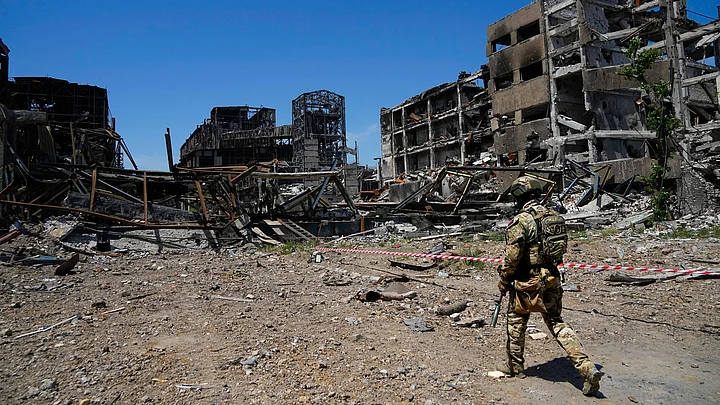When you invade a neighbouring country, armed resistance is to be expected. In addition to having to deal with Ukraine’s conventional forces, Russia is likely to find itself struggling to pacify the territory it has so far seized.
Continued resistance in occupied regions – both violent and nonviolent – challenges the Russian narrative as well as its strategy.
Russia has claimed that a series of “terrorist” attacks has been perpetrated against its troops in occupied Ukraine. A recent example is the alleged bombing of a cafe frequented by occupation forces in the city of Kherson in southern Ukraine.
This could be, as others have pointed out, a “false flag event” – something which Russia is well known for staging.
But, if we accept the report at face value, the attack does fall within a broader pattern of organised resistance directed at the Russian side in recently seized territory.
In addition to conducting significant preparation and training, Ukraine had a legal and administrative framework in place to conduct a whole-of-society resistance well before the invasion.
Given the perception of Russian military capabilities at the time, this was very much the war that the Ukrainian side planned on fighting.
The Russians, planning for a swift “liberation” of Ukraine, probably did not plan on confronting a serious resistance of any nature. So they appear to lack a strategy to contend with the forces that remain in captured districts.
Fierce Resistance
Ukrainian resistance has been much fiercer than expected – and this is as true in occupied regions as it is on the front lines. In Kherson alone, there has been sabotage, attempted assassinations and direct attacks on Russian forces – though not all reported attacks have been accurate.
Also, the collaborators Russia was counting on to assist with its administration of these territories have not materialised in sufficient numbers.
Even more worrying for Moscow, Russia is struggling to maintain basic public services in the regions it has seized.
Interestingly, some sources have suggested that the war is also encouraging resistance in areas occupied by Russia or its proxies prior to February, though this is difficult to confirm.
The true scale of Ukrainian resistance forces in occupied areas is also difficult to reliably judge. As well as the “partisan” forces specially trained and equipped to fight, there seems to be a place for anyone who wants to oppose occupation.
Of course, Ukraine will naturally emphasise the impact of resistance movements, while Russia wants to undermine the legitimacy and scale of any Ukrainian activity behind its front line.
It’s not inconceivable that some Ukrainian resistance actions may fall outside the rules of law. But, by most reasonable metrics, Ukraine’s resistance forces will fall within the definition of combatant, not terrorist, so long as they respect the Geneva Conventions.
In this regard, the framing of the Ukrainian resistance actions as terrorist has more to do with the Russian worldview than objective reality – after all, this is how they have been referring to Ukrainian conventional forces as well.
Russia has clearly had to heavily modify its initial objectives since beginning operations, though it undoubtedly wishes to maintain control over the regions it has so far captured.
Regarding captured territory in southern Ukraine, Russia has announced its intentions to stay “forever”.
To accomplish this it is attempting to “Russify” captured areas, solidifying its control by replacing civil administration with pro-Russian collaborators.
Occupiers are also changing the currency and providing humanitarian support, ultimately eyeing a Crimea-style annexation of cities like Kherson.
This will be extremely difficult to accomplish. Given the level of resistance, Russia may have to rethink even the adjusted objectives it has adopted for the conflict.
Implications For the Conflict
By some estimations, Russia holds upwards of 20% of Ukrainian territory. In this regard, it may have bitten off more than it can chew. At the moment, Russia is having to confront both a conventional military and irregular partisan forces, which places it in an uncomfortable position.
If the resistance were to spread beyond the territories captured by Russia since February, then this would have further implications. Russia has controlled Crimea as well as parts of eastern Ukraine since 2014.
The emergence of serious organised resistance in these areas would not only represent a further drain on Russia’s limited resources but further damage Moscow’s self-perception as a liberating force.
To effectively respond, Russia may have to fall back upon the more brutal means of subjugation that it has used in the past. Recent Russian history with counterinsurgency has been summarised as grim but successful.
Conflicts against Chechen separatists and in support of the Syrian regime have demonstrated Russia’s effective use of terror and reprisals to quell resistance movements.
Of course, Russian solutions generate Russian problems, and a more aggressive approach in occupied territory could ultimately generate issues for the regime, further driving the nation into isolation.
We also don’t know how the Russian military might fare in those other theatres today, despite its past successes in counterinsurgency. The heavily traumatised and demoralised Russian land forces may simply no longer have the resources they need.
The Ukrainian resistance is clearly capable of more than a few isolated bombings.
It is able to impose significant costs on the Russian occupation, and its success compounds the failure of both Russia’s imperial vision for Ukraine and its programme of Russification.
Ultimately, holding territory might prove more costly for Russia than acquiring it in the first place.
Far from expanding and renovating the Russian Empire, territorial expansion into Ukraine has opened a series of bleeding sores that will remain open as long as Russia maintains a presence in Ukraine.
(This is an opinion piece and the views expressed above are the author’s own. The Quint neither endorses nor is responsible for the same. This article was originally published on The Conversation. Read the original article here.)
(At The Quint, we question everything. Play an active role in shaping our journalism by becoming a member today.)
